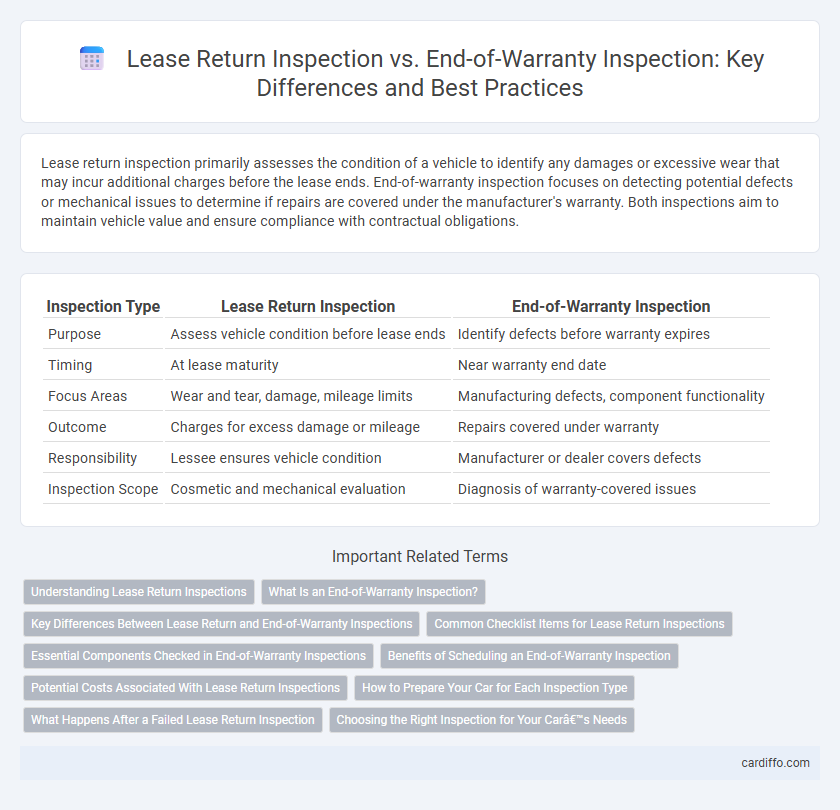Lease return inspection primarily assesses the condition of a vehicle to identify any damages or excessive wear that may incur additional charges before the lease ends. End-of-warranty inspection focuses on detecting potential defects or mechanical issues to determine if repairs are covered under the manufacturer's warranty. Both inspections aim to maintain vehicle value and ensure compliance with contractual obligations.
Table of Comparison
| Inspection Type | Lease Return Inspection | End-of-Warranty Inspection |
|---|---|---|
| Purpose | Assess vehicle condition before lease ends | Identify defects before warranty expires |
| Timing | At lease maturity | Near warranty end date |
| Focus Areas | Wear and tear, damage, mileage limits | Manufacturing defects, component functionality |
| Outcome | Charges for excess damage or mileage | Repairs covered under warranty |
| Responsibility | Lessee ensures vehicle condition | Manufacturer or dealer covers defects |
| Inspection Scope | Cosmetic and mechanical evaluation | Diagnosis of warranty-covered issues |
Understanding Lease Return Inspections
Lease return inspections primarily assess vehicle condition against lease agreement criteria, identifying wear and tear beyond normal use to determine potential charges. End-of-warranty inspections focus on verifying that all manufacturer-covered defects and recalls have been addressed before the warranty expires. Understanding lease return inspections ensures lessees avoid unexpected fees by documenting vehicle condition precisely and scheduling necessary repairs prior to lease termination.
What Is an End-of-Warranty Inspection?
An end-of-warranty inspection is a thorough evaluation conducted near the conclusion of a product's warranty period to identify potential defects or issues covered under the warranty. This type of inspection ensures that repairs or replacements are addressed before the warranty expires, preventing out-of-pocket expenses for the owner. Unlike lease return inspections, which focus on vehicle condition relative to lease agreements, end-of-warranty inspections specifically aim to maximize warranty benefits and maintain product reliability.
Key Differences Between Lease Return and End-of-Warranty Inspections
Lease return inspections primarily assess cosmetic and mechanical conditions to ensure the vehicle complies with lease agreement standards, with a focus on wear and tear limits and excess mileage. End-of-warranty inspections evaluate the vehicle's overall performance and identify potential issues covered under the warranty to determine necessary repairs or maintenance before warranty expiration. Key differences include the scope--lease returns emphasize condition compliance for residual value, whereas end-of-warranty inspections concentrate on detecting defects to prevent out-of-pocket repair costs.
Common Checklist Items for Lease Return Inspections
Lease return inspections primarily focus on identifying excessive wear and tear, verifying tire condition, checking for paint damage, and assessing interior cleanliness to ensure the vehicle meets lease agreement standards. Evaluating mechanical components such as brakes, lights, and fluid levels helps detect any needed repairs that could incur charges. Comparing the vehicle's mileage against lease limits and documenting any dents, scratches, or windshield chips are crucial for accurate lease return processing.
Essential Components Checked in End-of-Warranty Inspections
End-of-warranty inspections primarily focus on essential components such as the engine, transmission, brakes, and electrical systems to identify defects covered under manufacturer warranty. These inspections ensure that any necessary repairs or replacements are completed before warranty expiration to avoid out-of-pocket expenses. Unlike lease return inspections, which assess overall vehicle condition and wear, end-of-warranty inspections prioritize detecting functional and mechanical faults tied to warranty claims.
Benefits of Scheduling an End-of-Warranty Inspection
Scheduling an end-of-warranty inspection ensures potential vehicle issues are identified and repaired before the warranty expires, maximizing coverage benefits. This proactive approach helps avoid costly repairs by addressing minor problems early, maintaining the vehicle's reliability and resale value. End-of-warranty inspections provide detailed reports that support informed decisions about maintenance and lease return conditions, reducing unexpected expenses.
Potential Costs Associated With Lease Return Inspections
Lease return inspections often reveal wear-and-tear damages that exceed normal use, leading to potential fees for repairs or excess mileage charges that can significantly impact the lessee's final costs. End-of-warranty inspections primarily focus on identifying defects covered by the manufacturer's warranty, usually minimizing out-of-pocket expenses unless damage falls outside warranty terms. Understanding the differences in inspection criteria helps lessees anticipate financial liabilities associated with lease returns, including penalty fees and repair costs not typically seen in end-of-warranty assessments.
How to Prepare Your Car for Each Inspection Type
Preparing your car for a lease return inspection requires addressing cosmetic repairs, ensuring all fluids are topped off, and removing personal items to meet lease return standards. For an end-of-warranty inspection, focus on a thorough mechanical checkup, updating required maintenance, and documenting all repairs to validate warranty claims. Both inspections benefit from detailed service records and a clean, well-maintained vehicle to avoid unexpected charges or denied coverage.
What Happens After a Failed Lease Return Inspection
After a failed lease return inspection, the lessee is typically responsible for covering the cost of necessary repairs or excess wear and tear charges as outlined in the lease agreement. The leasing company may provide an itemized report detailing damages, which must be addressed before the vehicle can be released or traded in. Failure to resolve these issues can result in additional fees or impact the lessee's ability to lease or finance future vehicles.
Choosing the Right Inspection for Your Car’s Needs
Lease return inspections primarily assess vehicle condition against lease agreement standards, focusing on wear and tear to avoid penalties, while end-of-warranty inspections identify potential defects covered by the manufacturer's warranty to ensure repairs are addressed before expiry. Selecting the right inspection depends on your car's ownership status and goals: lease return if you're ending a lease to prevent unexpected charges, or end-of-warranty if you want to maximize warranty benefits and maintain resale value. Understanding inspection criteria, coverage, and timing helps optimize vehicle care and financial outcomes.
Lease return inspection vs end-of-warranty inspection Infographic

 cardiffo.com
cardiffo.com